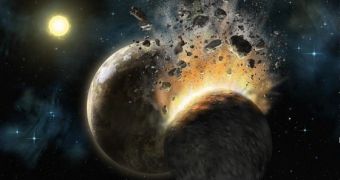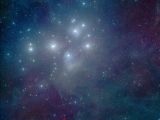Rocky planets similar to our own could be forming in the Pleiades cluster, astronomers reported on Wednesday. HD 23514, a star within the cluster is surrounded by a number of hot dust particles that could form the building block necessary to build planets. The discovery of the dust cloud, is the first evidence that rocky planets might be forming in the cluster, and solar systems similar to our own might be as common as the stars themselves.
The lead author of the research, Joseph Rhee, postdoctoral scholar in astronomy at the University of California, Los Angeles, found that there is a mass of hundreds of thousands of times as much dust as around the Sun, and suggests that it could be remnant debris from a collision.
HD 23514 is located in the Pleiades cluster, constellation of Taurus, about 400 light years away from Earth, making the Pleiades one of the closest stellar clusters. The Pleiades is well known, and has been considered important in many cultures around the globe, such as the Greek culture, which named the cluster after the seven daughters of Atlas and Pleione, who were placed by Zeus among the stars in mythology.
It is one of the most visible objects in the sky with the naked eye. Though Atlas and Pleione only had seven stars, the cluster packs more than 1,400 stars.
Spectral analysis of the emissions from the cloud of dust particles suggested to the researchers that the only explanation for this amount of debris is that it comes from a monstrous collision of planets or planetary embryos. Clouds of dust spinning around stars, are the basic building blocks of planets, and collapse to form small bodies such as comets and asteroids, which eventually bundle together to form bigger bodies, like planetary embryos, and finally planets. While some of the objects group together to form planets, others are shattered by collisions.
Similar planet forming systems have been found previously around a star known as BD +20 307, located 300 light years away from Earth, in the constellation of Aries, which is also surrounded by enormous amounts of dust, totaling a mass of one million times that orbiting the Sun. After the discovery in 2005, researches went to find similar stars surrounded by large clouds of dust, by analyzing the infrared light emitted by bodies such as our own, and found the HD 23514.
The stars in the Pleiades cluster, are relatively young, Pleiades and Aries stars have only 100 million and respectively 400 million years, compared to the age of our Sun, of about 4.5 billion years. By studying these two stars, astronomers concluded that young sun-like stars are most likely to form rocky planets similar to our own, through violent collisions of more massive objects.
A similar collision might be responsible for the large Moon orbiting our planet. Scientists believe that a planet the size of Mars collided with a planetary embryo, and the resulting debris condensed to form the Moon and the Earth. The calculations reveal that the dust debris around HD 23514 is the result of a collision that took place only a few hundred thousands years ago.
The collision between planetary embryos is the only valid explanation for the presence of the large dust cloud. 10 million years old stars or younger might have such amounts of dust in their orbit, but by the time it reaches 100 million years, they get dissipated by solar wind, or drawn into the star, or collapse to form planets.
The study has been mainly done by using the Gemini 8-meter Frederick C. Gillett Telescope, and several infrared observatories, including the Spitzer Space Telescope.

 14 DAY TRIAL //
14 DAY TRIAL // 
